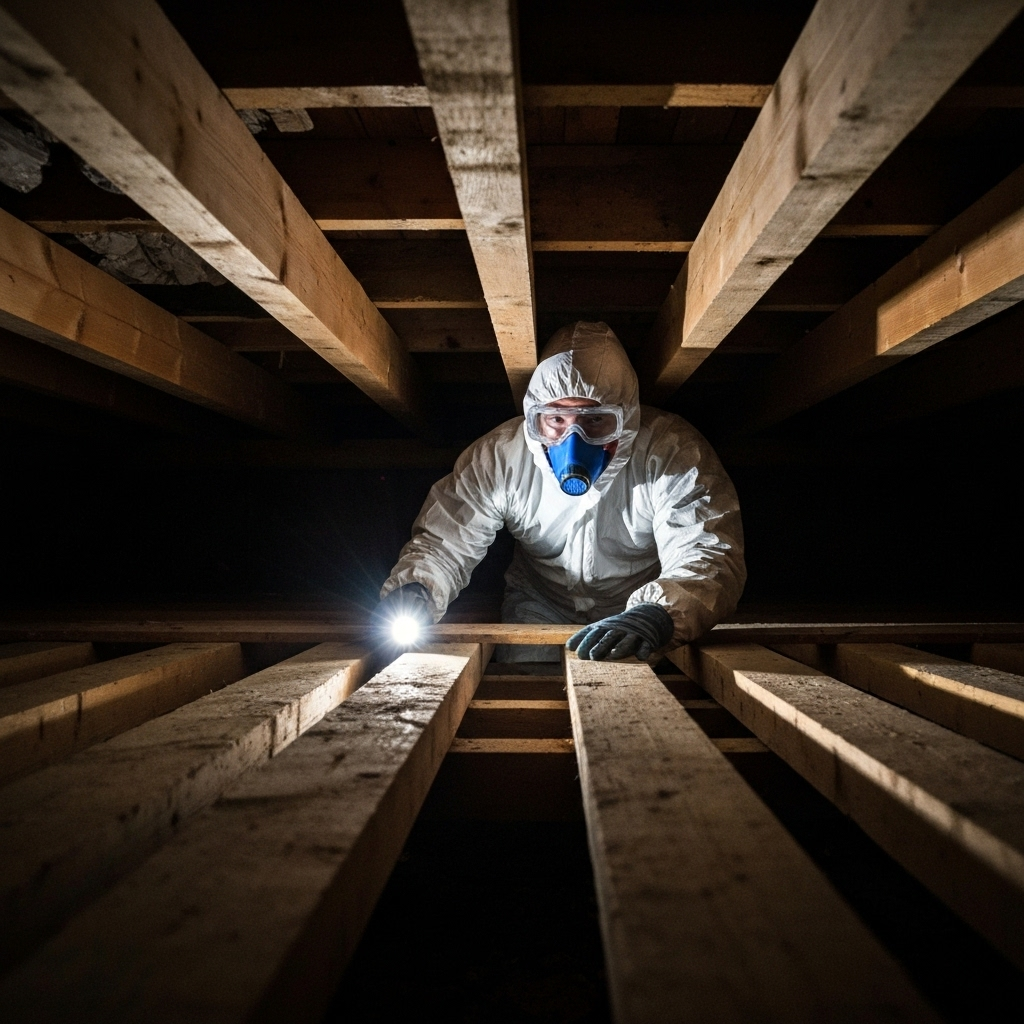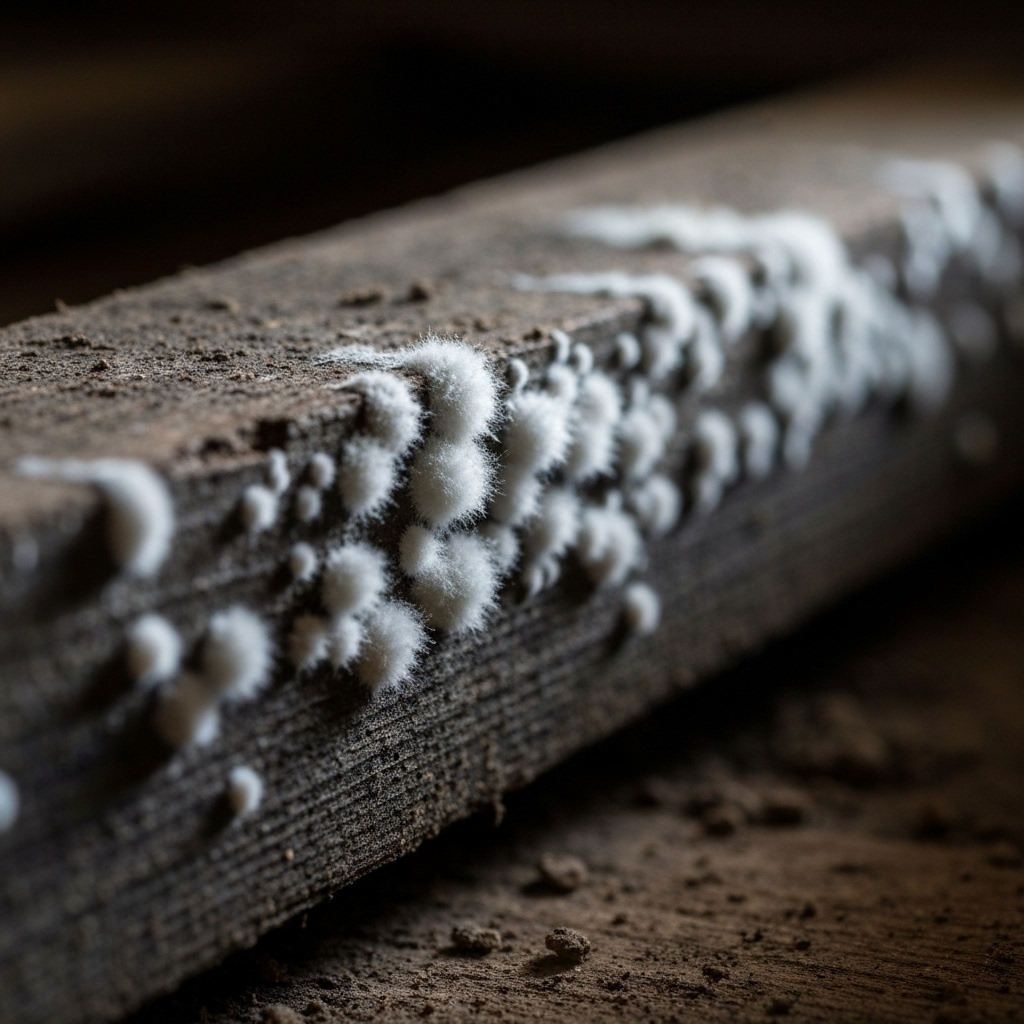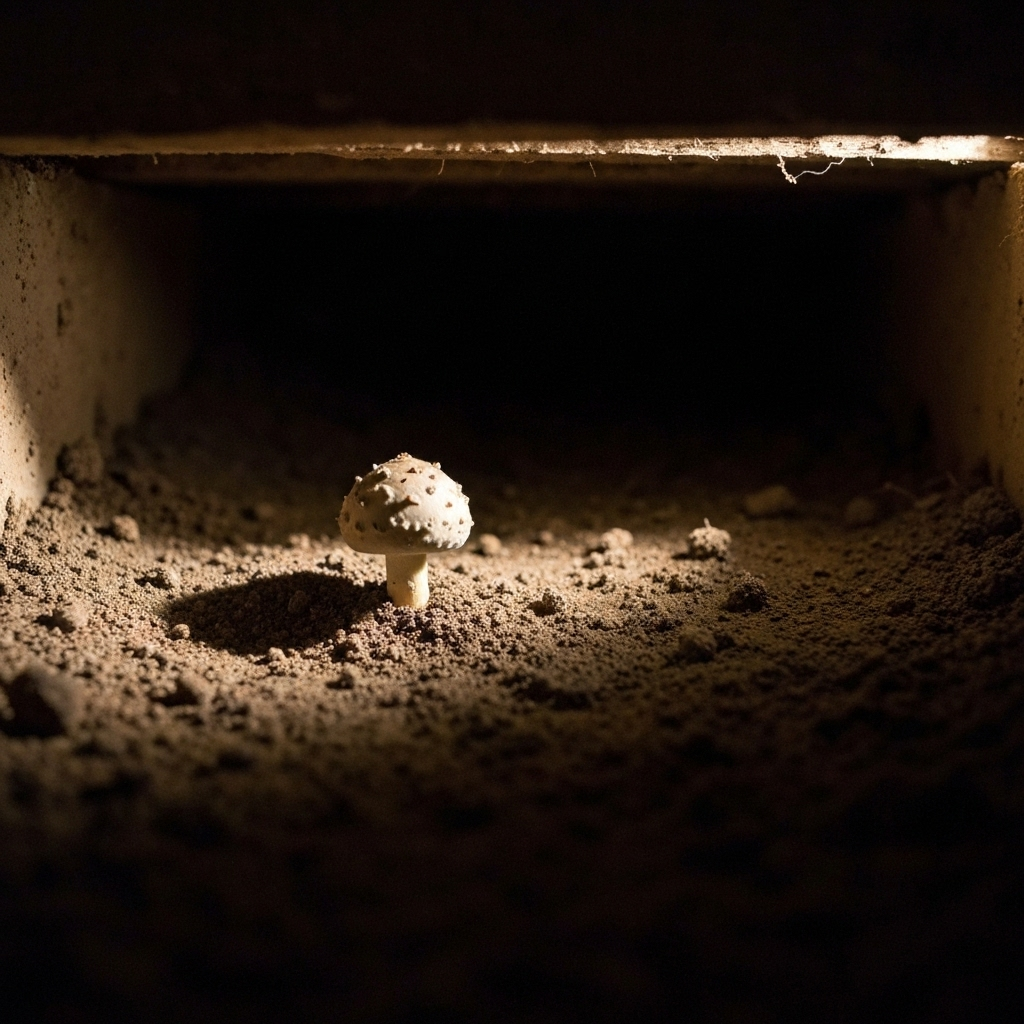Identification
Is That Mold in Your Crawlspace? A Homeowner's Guide to Identification
Worried about mold in your crawlspace? Learn the signs, what it looks like, and how to safely inspect. Get clear steps for identification and action.
Fast facts
- Crawlspaces are high-risk for mold due to persistent moisture, darkness, and poor ventilation.
- A musty, earthy smell is a primary indicator of hidden mold growth, even if you can't see it.
- Visually, mold can be white, black, or green and appear fuzzy, slimy, or powdery. It is often confused with efflorescence.
- Always wear safety gear (N95 mask, gloves, goggles) before entering and inspecting your crawlspace.
- Document any suspected mold with photos and use a tool like Mold Detector AI for a quick, initial analysis before deciding on next steps.
Photo examples




Out of Sight, Out of Mind? Not When It Comes to Your Crawlspace
Your crawlspace is one of the most neglected areas of your home, but it's also one of the most critical for your home's structural integrity and your family's health. Dark, damp, and often undisturbed, it’s the perfect five-star resort for mold. Ignoring a potential mold in crawlspace issue is a risk you can't afford to take. The air in your crawlspace inevitably circulates into your living areas, carrying mold spores with it.
This guide is your first line of defense. We’ll walk you through the telltale signs, what to look for, and what to do if you suspect you have a mold problem lurking beneath your floors. Let's get practical and proactive.
Why Your Crawlspace is a Mold Magnet
Understanding the 'why' is the first step toward prevention and identification. Mold needs just a few things to thrive, and your crawlspace provides them all in abundance.
- Moisture: This is the number one culprit. Leaky pipes, foundation cracks, high humidity, and poor drainage can all introduce moisture that gets trapped in the enclosed space.
- Darkness: Mold is sensitive to UV light. Your dark crawlspace provides the perfect cover for it to grow unchecked.
- Food Source: Mold isn't picky. It happily feeds on organic materials like the wood joists, beams, subflooring, and even paper backing on insulation that make up your home's foundation.
- Stagnant Air: Poor ventilation traps moist air, creating a humid microclimate where mold spores can easily settle and colonize.
The Telltale Signs: Engaging Your Senses
Before you even peek inside, your home might be giving you clues. Pay attention to these early warning signs.
The Unmistakable Smell
This is often the first and most obvious indicator. If you notice a persistent musty, earthy, or damp sock-like odor, especially when your HVAC system kicks on or in rooms directly above the crawlspace, it's a major red flag. Your nose knows. That smell is caused by Microbial Volatile Organic Compounds (MVOCs), which are gasses produced by mold during its metabolic process. Don't just cover it with air fresheners—investigate the source.
Subtle Health Symptoms
The air you breathe in your home rises from the lower levels. This is known as the "stack effect." If mold is present in your crawlspace, its spores and byproducts can easily travel into your living space. For sensitive individuals, this can trigger:
- Increased allergy symptoms (sneezing, runny nose, itchy eyes)
- Unexplained headaches
- Respiratory irritation or a persistent cough
- Skin rashes
If these symptoms worsen when you're at home, it might be linked to your indoor air quality, and the crawlspace is a prime suspect.
A Visual Inspection Guide: What Does Crawlspace Mold Look Like?
Okay, it's time to gear up and take a look. But what exactly are you looking for? Mold doesn't always look like the stereotypical black splotches you see in movies.
Safety First: Prepare for Inspection
Do not enter your crawlspace without proper protection. The enclosed area can concentrate airborne spores. At a minimum, wear:
- An N95 or P100 respirator mask
- Goggles or safety glasses
- Gloves
- Old, long-sleeved clothing you can wash immediately
Bring a powerful flashlight or headlamp. Your phone's light won't be enough.
Colors and Textures to Watch For
Shine your light on floor joists, the subfloor, insulation, and along the foundation walls. Look for discoloration or growth that stands out from the surrounding material.
- White Mold: Often appears light, fluffy, or powdery. It can grow extensively on wood joists and can sometimes be mistaken for efflorescence.
- Black Mold: This is the one everyone fears. It can range from dark green to jet black and often looks slimy or sooty. While many molds are black, not all are the toxigenic "Stachybotrys chartarum." All mold, however, should be treated as a potential health risk.
- Green or Blue Mold: These are very common and can have a fuzzy appearance, often associated with water-damaged areas.
- Yellow Mold: Often found on wood, this type of mold can look like a yellowish-brown slime or film.
Is It Mold or Efflorescence? A Common Mix-Up
On concrete or brick foundation walls, you may see a white, crystalline, or powdery substance. This is often efflorescence, which is salt deposits left behind as water evaporates from the masonry. It's not mold, but it is a clear sign of a moisture problem that could lead to mold.
How to tell the difference quickly?
- Efflorescence: Crumbles into a fine powder when you pinch it. It will also dissolve in water.
- White Mold: Is a living organism. It will feel more like soft fuzz or slime and will not dissolve in water.
When you're looking at a suspicious white patch on a joist or wall, the distinction isn't always clear to the naked eye. This is where an unbiased analysis can save you time and worry.
I Found Something. Now What?
Finding suspected mold can be stressful, but a clear plan of action makes all the difference. Don't panic—document and diagnose.
Step 1: Take Clear Photos
Before you disturb anything, use your smartphone to take several clear, well-lit photos from different angles and distances. Capture wide shots to show the extent of the growth and close-ups to show the texture and color. These photos are your most valuable record.
Step 2: Get a Fast, Data-Driven First Opinion
You have the photos, but you're still not sure what you're looking at. Is it dangerous? Is it just efflorescence? Instead of guessing, get an immediate analysis.
Not sure if that's mold? Upload your photo to Mold Detector AI and get instant results.
Our AI has been trained on thousands of images of mold and its lookalikes. It can help you quickly distinguish between mold and other substances, giving you the confidence to decide your next step without waiting for an expensive in-person consultation for an initial ID.
Step 3: Assess the Scope of the Problem
Based on your inspection and analysis, determine the size of the affected area. The EPA generally suggests that if the moldy area is less than about 10 square feet (roughly a 3x3 foot patch), you may be able to handle the cleanup yourself with the proper safety precautions. If the problem is larger, it's time to call in the experts.
When You Absolutely Must Call a Professional
DIY is not always the answer. The risks of improper removal are too high, as you could spread spores throughout your home. Call a certified mold remediation professional if:
- The mold covers more than 10 square feet.
- You suspect the mold has gotten into your HVAC system.
- There is significant structural rot or damage to the wood.
- The crawlspace has been flooded or contains standing water.
- Members of your household are experiencing severe health symptoms.
A professional will not only remove the mold but will also identify and fix the underlying moisture source, which is the only way to ensure the mold doesn't return.
Your Crawlspace Is Your Home's Foundation—Keep It Healthy
Discovering mold in your crawlspace is unsettling, but it’s a problem you can solve. By performing regular inspections, controlling moisture, and acting quickly at the first sign of trouble, you protect both your property investment and, more importantly, your family’s well-being. Use tools like Mold Detector AI as your partner in identification, and never hesitate to call for professional help when the job is too big to handle alone. A dry, clean crawlspace is the foundation of a healthy home.
Ready to put this into action?
Not sure if that's mold? Upload your photo to Mold Detector AI and get instant results.
Launch Mold Detector AI